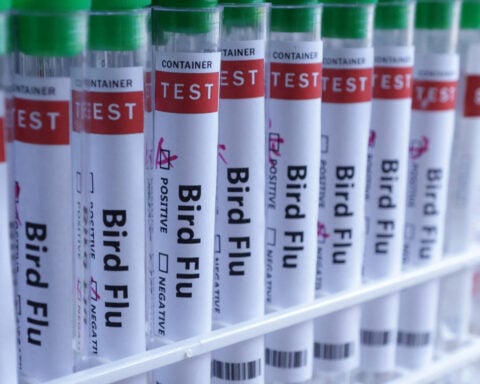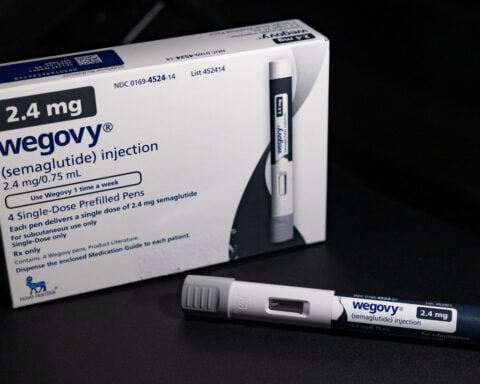(CNN) — California Governor Gavin Newsom has signed into law a bill that bans the use of red dye No. 40 and five other chemicals from use in foods served at public schools.
On September 28, the Golden State became the first in the country to pass a law forbidding the use of the ingredients found in some popular cereals, ice creams, drinks, candy, ice pops, cheese-flavored chips, jellies and more, according to the Environmental Working Group, a nonprofit environmental health organization that cosponsored the law with Consumer Reports. The law will be enacted on December 31, 2027.
Known as the California School Food Safety Act and introduced by Democratic Assemblymember Jesse Gabriel in February, Assembly Bill 2316 prohibits a school district, county superintendent of schools or charter school with grades kindergarten through 12th from offering foods or beverages containing red dye No. 40, yellow dyes Nos. 5 and 6, blue dyes Nos. 1 and 2, and green dye No. 3. Some of these dyes are found in some, but not all, products under the Cheetos, Doritos, Skittles, M&Ms, Starburst, Gatorade, Mountain Dew, Cap’n Crunch, Ruffles and Takis brands.
CNN has reached out to the owners of these brands for comment. Barcel USA, manufacturer of Takis, declined to comment.
California is home to the largest public school system in the nation, with more than 6.3 million students and 10,000 schools, Tony Thurmond, state superintendent of public instruction and bill cosponsor, said in a news briefing hosted by the EWG on August 6.
The bill stems from concerns these dyes would harm children’s ability to learn, as they have been linked to behavioral difficulties and decreased attention among children, according to a 2021 study by the California Office of Environmental Health Hazard Assessment.
“California is once again leading the nation when it comes to protecting our kids from dangerous chemicals,” Gabriel said in a news release.
The law is “important to me as a parent, it’s important to me as somebody who’s struggled with ADHD as a child, and it’s important to me as a parent of a child who is struggling with ADHD,” Gabriel said in the August briefing. “We know that the synthetic food dyes that are targeted by this bill can cause harm for all kids, but we know that there is a specially pronounced impact on a lot of our young people with ADHD and other challenges.”
Gabriel and the EWG said that though “new science is available,” the US Food and Drug Administration’s current regulations of the dyes in food is based on research that’s 35 to 70 years old.
The FDA’s response
Enhancing food chemical safety is among the FDA’s top priorities, a spokesperson for the federal agency said via email.
“Over the past few years, there have been an increasing number of state bills to ban certain additives and set limits for certain contaminants,” the spokesperson added. “And while states are well within their rights under our current regulatory system to do so, a strong national food safety system is not built state by state.”
In August, when the bill was passed by the California Legislature, the agency said it had reviewed the research on the effects of color additives on children’s behavior, including the review cited by the bill. The FDA found that overall, “most children have no adverse effects when consuming foods containing color additives, but some evidence suggests that certain children may be sensitive to them.”
In addition to the FDA’s own evaluations, the agency also supports and participates in international risk assessments conducted under the Joint Food and Agriculture Organization of the United Nations/World Health Organization Expert Committee on Food Additives, an FDA spokesperson said in August.
“All the colors listed have recently undergone assessments for safety in food by the JEFCA and were found to be safe for use in food under current use conditions,” the FDA said.
The agency now says it “must lead the way on food chemical safety” and is modernizing its approach to post-market chemical safety assessments in response to growing public demand for the FDA to do more to ensure the safety of chemicals in the US food supply.
The FDA held a public meeting in September on the development of an enhanced systematic process for the agency’s post-market assessment of chemicals in food, and currently has a docket open for comment, according to the spokesperson.
“Under the new Human Foods Program, by instituting a systematic approach for chemical reassessment, the FDA is making the types of changes to our oversight program that will support equal access to safe foods, a resilient food supply, and maintain consumer confidence.”
Impacts of AB 2316
John Hewitt of the Consumer Brands Association, which represents more than 1,700 brands, said in a statement in August that “it’s unfortunate that scientifically proven, safe ingredients have been demonized for the purpose of advancing a political agenda.
“No industry is more committed to food safety than the consumer packaged goods industry. It’s why we have urged the FDA to aggressively acknowledge its responsibility as the nation’s food safety regulator,” Hewitt, senior vice president of packaging and sustainability and state affairs at the association, said via email. “The passage of this bill could cost schools and families money, limit choice and access, and create consumer confusion.”
But Thurmond stressed the greater importance of “the cost of our failure to act … in a nation where our children already have some of the highest rates of illness, asthma, diabetes (and) heart disease,” compared with other countries.
Gabriel echoed these sentiments, adding that the bill may ultimately save California money by reducing the use of resources necessary for helping children struggling in the classroom.
“I see this both through personal experience and also the work that I do as a lawmaker,” he added. “It’s really expensive.”
Newsom’s decision renders the United States food environment more in alignment with that of the European Union, where products including these dyes are required to have a warning label saying those products could harm young people, Gabriel added.
“The point of this bill is to encourage manufacturers to make minor modifications to their recipes, so that they can serve the same foods that we all love, that our kids love, but without these dangerous chemicals that harm people,” he added. “We have incredible confidence that they’re able to do that … because they make the same products in so many countries around the world, just without the harmful chemicals.”
The EWG has noted in the past that few foods available in California schools use the ingredients the bill bans.
However, Gabriel and other assemblymembers believe that given the size of California’s economy, the law is a “major victory for the food safety movement not only here in the state of California, but also nationally,” he said, also noting that more than 70 organizations support the bill.
After the state banned brominated vegetable oil, used mostly in some sodas, as part of its California Food Safety Act in October 2023, the US Food and Drug Administration revoked the regulation for its use nine months later.
And at least 10 other states have begun following California’s lead, introducing legislation based on the act, Gabriel said.
Avoiding these chemicals in food
If you’re concerned about the potential impacts of these dyes on your child’s health, you can help them avoid them by checking the ingredient lists of any products you buy, experts said — particularly packaged foods, which are typically ultra-processed and thus are more likely to include artificial dyes, according to the EWG.
You can also try alternatives without those ingredients — foods that are USDA-certified organic, for example, can’t contain artificial food dye. Cut back on sodas, juices or sports drinks that might contain them, as well. Offering kids substitutes may be more effective than flat-out denial of something they’re craving.
“Emphasize brightly colored produce,” the EWG suggests. “The best competition for splashy packages of ultra-processed foods is the rainbow of colors in fresh fruit and vegetables.”
Actress Lesley-Ann Brandt has ongoing conversations with her 7-year-old son about which foods are more or less healthy to eat and why, she said in the briefing.
“We talk to him as if he’s an adult, and he knows we don’t eat this because of this, but here’s an alternative,” Brandt said. “We make some of our foods too, and it’s a way to discuss nutrition.”
Brandt has witnessed the benefits of nutrition in her family of origin, too, she added. After growing up in two “very different” food systems of South Africa and New Zealand, “I really noticed the difference coming to the States 14 years ago,” she said.
“I’m also the oldest sister of a brother who had severe ADHD as a child, so I got to see firsthand the impact of nutrition and how it helped him,” Brandt said. “One of the first things my mother did to try and avoid heavily medicating him was to look at his nutrition and the processed sugars, ingredients, food dyes and synthetic chemicals that just (were) not going to serve him in school.
“And it was really the difference between a B student and a C student for him,” she said. “That impacted his confidence as well.”
The-CNN-Wire
™ & © 2024 Cable News Network, Inc., a Warner Bros. Discovery Company. All rights reserved.

 Trump has begun another trade war. Here's a timeline of how we got here
Trump has begun another trade war. Here's a timeline of how we got here
 Canada's leader laments lost friendship with US in town that sheltered stranded Americans after 9/11
Canada's leader laments lost friendship with US in town that sheltered stranded Americans after 9/11
 Chinese EV giant BYD's fourth-quarter profit leaps 73%
Chinese EV giant BYD's fourth-quarter profit leaps 73%
 You're an American in another land? Prepare to talk about the why and how of Trump 2.0
You're an American in another land? Prepare to talk about the why and how of Trump 2.0
 Chalk talk: Star power, top teams and No. 5 seeds headline the women's March Madness Sweet 16
Chalk talk: Star power, top teams and No. 5 seeds headline the women's March Madness Sweet 16
 Purdue returns to Sweet 16 with 76-62 win over McNeese in March Madness
Purdue returns to Sweet 16 with 76-62 win over McNeese in March Madness








